Related Research Articles

A meteorite is a rock that originated in outer space and has fallen to the surface of a planet or moon. When the original object enters the atmosphere, various factors such as friction, pressure, and chemical interactions with the atmospheric gases cause it to heat up and radiate energy. It then becomes a meteor and forms a fireball, also known as a shooting star; astronomers call the brightest examples "bolides". Once it settles on the larger body's surface, the meteor becomes a meteorite. Meteorites vary greatly in size. For geologists, a bolide is a meteorite large enough to create an impact crater.
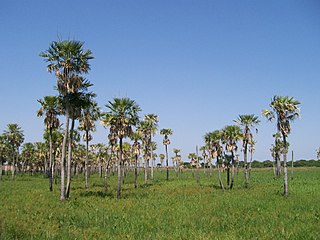
Chaco, officially the Province of Chaco, is one of the 23 provinces in Argentina. Its capital and largest city, is Resistencia. It is located in the north-east of the country.

Campo del Cielo refers to a group of iron meteorites and the area in Argentina where they were found. The site straddles the provinces of Chaco and Santiago del Estero, located 1,000 kilometers (620 mi) north-northwest of Buenos Aires, Argentina and approximately 500 kilometres (310 mi) southwest of Asunción, Paraguay. The crater field covers 18.5 by 3 kilometres and contains at least 26 craters, the largest being 115 by 91 metres.
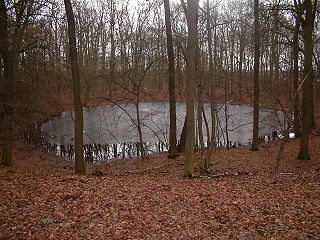
The Morasko meteorite nature reserve is located in Morasko, on the northern edge of the city of Poznań, Poland. It contains seven meteor craters. The reserve has an area of 55 hectares and was established in 1976.

The Willamette Meteorite, officially named Willamette and originally known as Tomanowos by the Clackamas Chinook Native American tribe, is an iron-nickel meteorite found in the U.S. state of Oregon. It is the largest meteorite found in the United States and the sixth largest in the world. There was no impact crater at the discovery site; researchers believe the meteorite landed in what is now Canada or Montana, and was transported as a glacial erratic to the Willamette Valley during the Missoula Floods at the end of the last Ice Age. It has long been held sacred by indigenous peoples of the Willamette Valley, including the federally recognized Confederated Tribes of the Grand Ronde Community of Oregon (CTGRC).

The Cape York meteorite, also known as the Innaanganeq meteorite, is one of the largest known iron meteorites, classified as a medium octahedrite in chemical group IIIAB. In addition to many small fragments, at least eight large fragments with a total mass of 58 tonnes have been recovered, the largest weighing 31 tonnes. The meteorite was named after Cape York, a prominent geographic feature located approximately 30 miles (48 km) west of the east coast of Meteorite island and the nearby peninsulas in northern Melville Bay, Greenland, where the first meteorite fragments were discovered.

Iron meteorites, also called siderites or ferrous meteorites, are a type of meteorite that consist overwhelmingly of an iron–nickel alloy known as meteoric iron that usually consists of two mineral phases: kamacite and taenite. Most iron meteorites originate from cores of planetesimals, with the exception of the IIE iron meteorite group.

The Hoba meteorite is named after the farm Hoba West, where it lies, not far from Grootfontein, in the Otjozondjupa Region of Namibia. It has been uncovered, but because of its large mass, has never been moved from where it fell. The main mass is estimated at more than 60 tonnes. It is the largest known intact meteorite and about twice as massive as the largest fragment of either the Cape York meteorite's 31-tonne Ahnighito kept in the American Museum of Natural History or the Campo del Cielo's 31-tonne Gancedo in Argentina. It is also the most massive naturally occurring piece of iron known on Earth's surface. The name Hoba comes from a Khoekhoegowab word meaning 'gift'. Following its donation to the government in 1987, a visitor centre was constructed with a circular stone access and seating area.
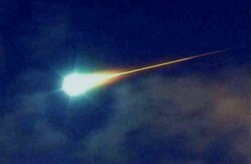
A meteorite fall, also called an observed fall, is a meteorite collected after its fall from outer space was observed by people or automated devices. Any other meteorite is called a "find". There are more than 1,300 documented falls listed in widely used databases, most of which have specimens in modern collections. As of February 2023, the Meteoritical Bulletin Database had 1372 confirmed falls.

Pultusk is an H5 ordinary chondrite meteorite which fell on 30 January 1868 in Poland near the town of Pułtusk. The event has been known as the stony meteorite shower with the largest number of pieces yet recorded in history. Made up of rocky debris, it consists of pyroxene or olivine chondrules deployed in massive plagioclase. Kamacite is also reported.

Park Forest is an L5 chondrite meteorite that fell on 26 March 2003 in Illinois, United States.

Seymchan is a pallasite meteorite found in the dry bed of the river Hekandue, a left tributary of river Yasachnaya in the Magadan district, Russia, near the settlement of Seymchan, in June 1967.
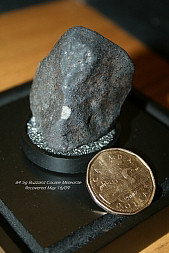
Buzzard Coulee is the collective name of the meteorites fallen on November 20, 2008 over Saskatchewan, Canada.
Gancedo is a village and municipality in Chaco Province in northern Argentina.
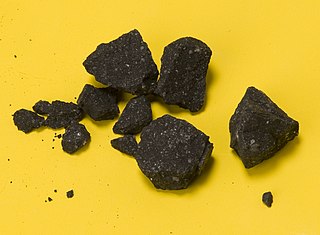
The Sutter's Mill meteorite is a carbonaceous chondrite which entered the Earth's atmosphere and broke up at about 07:51 Pacific Time on April 22, 2012, with fragments landing in the United States. The name comes from Sutter's Mill, a California Gold Rush site, near which some pieces were recovered. Meteor astronomer Peter Jenniskens assigned Sutter's Mill (SM) numbers to each meteorite, with the documented find location preserving information about where a given meteorite was located in the impacting meteoroid. As of May 2014, 79 fragments had been publicly documented with a find location. The largest (SM53) weighs 205 grams (7.2 oz), and the second largest (SM50) weighs 42 grams (1.5 oz).

The Novato meteorite is an ordinary chondrite which entered the Earth's atmosphere and broke up over Northern California at 19:44 Pacific Time on 17 October 2012. The falling bolide created a bright fireball and sonic booms and fragmented into smaller pieces as the intense friction of passing through the atmosphere heated it and absorbed its kinetic energy. The meteoroid was about 35 centimeters (14 in) across.

The Chelyabinsk meteor was a superbolide that entered Earth's atmosphere over the southern Ural region in Russia on 15 February 2013 at about 09:20 YEKT. It was caused by an approximately 18 m (59 ft) diameter, 9,100-tonne (10,000-short-ton) near-Earth asteroid that entered the atmosphere at a shallow 18.3 ± 0.4 degree angle with a speed relative to Earth of 19.16 ± 0.15 kilometres per second. The light from the meteor was briefly brighter than the Sun, visible as far as 100 km (60 mi) away. It was observed in a wide area of the region and in neighbouring republics. Some eyewitnesses also reported feeling intense heat from the fireball.
The following lists events that happened in Argentina in 2016.
References
- 1 2 Ferrara, Michele (Oct 25, 2016). "The second biggest meteorite discovered" (PDF). Free Astronomy Magazine. No. November-December 2016. Astro Publishing. p. 10. Archived from the original (PDF) on 2018-09-20. Retrieved 2018-09-19.
- ↑ "China meteorite: world's top 10 largest ever meteorites". The Telegraph . Retrieved 2018-09-19.
- 1 2 "Nota sobre el Descubrimiento, diálogo con Télam, de Mario Vesconi, presidente de la Asociación de Astronomía del Chaco" (in Spanish). 13 September 2016. Retrieved 2016-09-13.